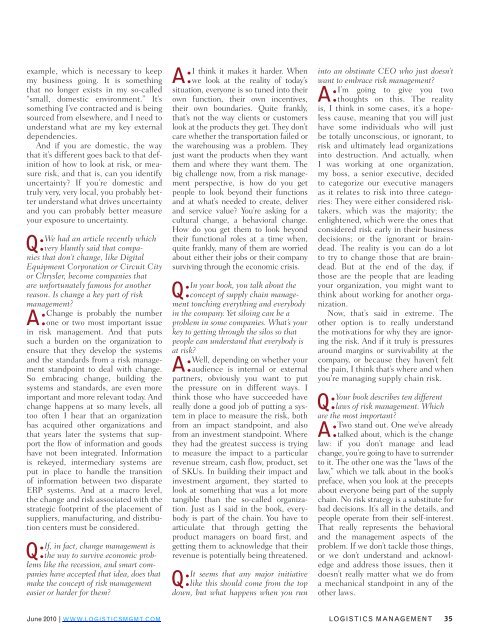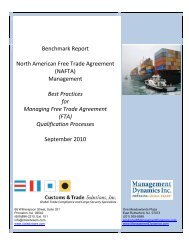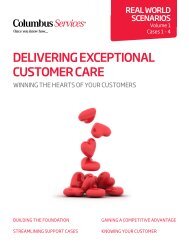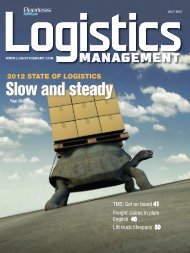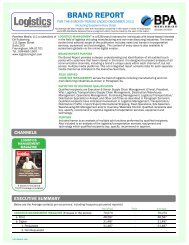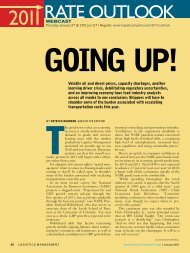Logistics Management - June 2010
Logistics Management - June 2010
Logistics Management - June 2010
Create successful ePaper yourself
Turn your PDF publications into a flip-book with our unique Google optimized e-Paper software.
example, which is necessary to keep<br />
my business going. It is something<br />
that no longer exists in my so-called<br />
“small, domestic environment.” It’s<br />
something I’ve contracted and is being<br />
sourced from elsewhere, and I need to<br />
understand what are my key external<br />
dependencies.<br />
And if you are domestic, the way<br />
that it’s different goes back to that definition<br />
of how to look at risk, or measure<br />
risk, and that is, can you identify<br />
uncertainty If you’re domestic and<br />
truly very, very local, you probably better<br />
understand what drives uncertainty<br />
and you can probably better measure<br />
your exposure to uncertainty.<br />
We had an article recently which<br />
Q: very bluntly said that companies<br />
that don’t change, like Digital<br />
Equipment Corporation or Circuit City<br />
or Chrysler, become companies that<br />
are unfortunately famous for another<br />
reason. Is change a key part of risk<br />
management<br />
Change is probably the number<br />
A: one or two most important issue<br />
in risk management. And that puts<br />
such a burden on the organization to<br />
ensure that they develop the systems<br />
and the standards from a risk management<br />
standpoint to deal with change.<br />
So embracing change, building the<br />
systems and standards, are even more<br />
important and more relevant today. And<br />
change happens at so many levels, all<br />
too often I hear that an organization<br />
has acquired other organizations and<br />
that years later the systems that support<br />
the flow of information and goods<br />
have not been integrated. Information<br />
is rekeyed, intermediary systems are<br />
put in place to handle the transition<br />
of information between two disparate<br />
ERP systems. And at a macro level,<br />
the change and risk associated with the<br />
strategic footprint of the placement of<br />
suppliers, manufacturing, and distribution<br />
centers must be considered.<br />
If, in fact, change management is<br />
Q: the way to survive economic problems<br />
like the recession, and smart companies<br />
have accepted that idea, does that<br />
make the concept of risk management<br />
easier or harder for them<br />
I think it makes it harder. When<br />
A: we look at the reality of today’s<br />
situation, everyone is so tuned into their<br />
own function, their own incentives,<br />
their own boundaries. Quite frankly,<br />
that’s not the way clients or customers<br />
look at the products they get. They don’t<br />
care whether the transportation failed or<br />
the warehousing was a problem. They<br />
just want the products when they want<br />
them and where they want them. The<br />
big challenge now, from a risk management<br />
perspective, is how do you get<br />
people to look beyond their functions<br />
and at what’s needed to create, deliver<br />
and service value You’re asking for a<br />
cultural change, a behavioral change.<br />
How do you get them to look beyond<br />
their functional roles at a time when,<br />
quite frankly, many of them are worried<br />
about either their jobs or their company<br />
surviving through the economic crisis.<br />
In your book, you talk about the<br />
Q: concept of supply chain management<br />
touching everything and everybody<br />
in the company. Yet siloing can be a<br />
problem in some companies. What’s your<br />
key to getting through the silos so that<br />
people can understand that everybody is<br />
at risk<br />
Well, depending on whether your<br />
A:<br />
audience is internal or external<br />
partners, obviously you want to put<br />
the pressure on in different ways. I<br />
think those who have succeeded have<br />
really done a good job of putting a system<br />
in place to measure the risk, both<br />
from an impact standpoint, and also<br />
from an investment standpoint. Where<br />
they had the greatest success is trying<br />
to measure the impact to a particular<br />
revenue stream, cash flow, product, set<br />
of SKUs. In building their impact and<br />
investment argument, they started to<br />
look at something that was a lot more<br />
tangible than the so-called organization.<br />
Just as I said in the book, everybody<br />
is part of the chain. You have to<br />
articulate that through getting the<br />
product managers on board first, and<br />
getting them to acknowledge that their<br />
revenue is potentially being threatened.<br />
It seems that any major initiative<br />
Q: like this should come from the top<br />
down, but what happens when you run<br />
into an obstinate CEO who just doesn’t<br />
want to embrace risk management<br />
I’m going to give you two<br />
A: thoughts on this. The reality<br />
is, I think in some cases, it’s a hopeless<br />
cause, meaning that you will just<br />
have some individuals who will just<br />
be totally unconscious, or ignorant, to<br />
risk and ultimately lead organizations<br />
into destruction. And actually, when<br />
I was working at one organization,<br />
my boss, a senior executive, decided<br />
to categorize our executive managers<br />
as it relates to risk into three categories:<br />
They were either considered risktakers,<br />
which was the majority; the<br />
enlightened, which were the ones that<br />
considered risk early in their business<br />
decisions; or the ignorant or braindead.<br />
The reality is you can do a lot<br />
to try to change those that are braindead.<br />
But at the end of the day, if<br />
those are the people that are leading<br />
your organization, you might want to<br />
think about working for another organization.<br />
Now, that’s said in extreme. The<br />
other option is to really understand<br />
the motivations for why they are ignoring<br />
the risk. And if it truly is pressures<br />
around margins or survivability at the<br />
company, or because they haven’t felt<br />
the pain, I think that’s where and when<br />
you’re managing supply chain risk.<br />
Your book describes ten different<br />
Q: laws of risk management. Which<br />
are the most important<br />
Two stand out. One we’ve already<br />
A: talked about, which is the change<br />
law: if you don’t manage and lead<br />
change, you’re going to have to surrender<br />
to it. The other one was the “laws of the<br />
law,” which we talk about in the book’s<br />
preface, when you look at the precepts<br />
about everyone being part of the supply<br />
chain. No risk strategy is a substitute for<br />
bad decisions. It’s all in the details, and<br />
people operate from their self-interest.<br />
That really represents the behavioral<br />
and the management aspects of the<br />
problem. If we don’t tackle those things,<br />
or we don’t understand and acknowledge<br />
and address those issues, then it<br />
doesn’t really matter what we do from<br />
a mechanical standpoint in any of the<br />
other laws.<br />
<strong>June</strong> <strong>2010</strong> | WWW.LOGISTICSMGMT.COM <strong>Logistics</strong> <strong>Management</strong> 35


